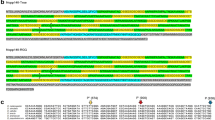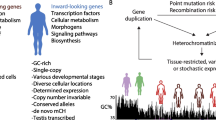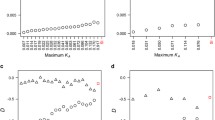Abstract
Palindromic sequences are important DNA motifs related to gene regulation, DNA replication and recombination, and thus, investigating the evolutionary forces shaping the distribution pattern and abundance of palindromes in the genome is substantially important. In this article, we analyzed the abundance of palindromes in the genome, and then explored the possible effects of several genomic factors on the palindrome distribution and abundance in Drosophila melanogaster. Our results show that the palindrome abundance in D. melanogaster deviates from random expectation and the uneven distribution of palindromes across the genome is associated with local GC content, recombination rate, and coding exon density. Our data suggest that base composition is the major determinant of the distribution pattern and abundance of palindromes and the correlation between palindrome density and recombination is a side-product of the effect of compositional bias on the palindrome abundance.



Similar content being viewed by others
References
Arndt PF, Burge CB, Hwa T (2003) DNA sequence evolution with neighbor-dependent mutation. J Comput Biol 10:313–322
Bartolome C, Maside X, Charlesworth B (2002) On the abundance and distribution of transposable elements in the genome of Drosophila melanogaster. Mol Biol Evol 19:926–937
Birdsell JA (2002) Integrating genomics, bioinformatics, and classical genetics to study the effects of recombination on genome evolution. Mol Biol Evol 19:1181–1197
Chu W, Ballard R, Schmind C (1997) Palindromic sequence preceding the terminator increase polymerase III template activity. Nucl Acids Res 25:2077–2082
Felsenstein J (1974) The evolutionary advantage of recombination. Genetics 78:737–756
Galtier N, Piganeau G, Mouchiroud D, Duret L (2001) GC-content evolution in mammalian genomes: the biased gene conversion hypothesis. Genetics 159:907–911
Gelfand MS, Koonin EV (1997) Avoidance of palindromic words in bacterial and archaeal genomes: a close connection with restriction enzymes. Nucl Acids Res 25:2430–2439
Hiratsu K, Mochizuki S, Kinashi H (2000) Cloning and analysis of the replication origin and the telomeres of the large linear plasmid pSLA2-L in Streptomyces rochei. Mol Gen Genet 263:1015–1021
Hua-Van A, Rouzic AL, Maisonhaute C, Capy P (2005) Abundance, distribution and dynamics of retrotransposable elements and transposons: similarities and differences. Cytogenet Genome Res 110:426–440
Hughes JF, Skaletsky H, Pyntikova T, Graves TA, van Daalen SK, Minx PJ, Fulton RS, McGrath SD, Locke DP, Friedman C, Trask BJ, Mardis ER, Warren WC, Repping S, Rozen S, Wilson RK, Page DC (2010) Chimpanzee and human Y chromosomes are remarkably divergent in structure and gene content. Nature 463:536–539
Karlin S, Mrazek J, Campbell AM (1997) Compositional biases of bacterial genomes and evolutionary implications. J Bacteriol 179:1363–1370
Kliman RM, Hey J (1993) Reduced natural selection associated with low recombination in Drosophila melanogaster. Mol Biol Evol 10:1239–1258
Langley CH, Lazzaro BP, Phillips W, Heikkinen E, Braverman JM (2000) Linkage disequilibria and the site frequency spectra in the su(s) and su(wa) regions of the Drosophila melanogaster X chromosome. Genetics 156:1837–1852
Leach DR (1994) Long DNA palindromes, cruciform structures, genetic instability and secondary structure repair. BioEssays 16:893–900
LeBlanc MD, Aspeslagh G, Buggia NP, Dyer BD (2000) An annotated catalog of inverted repeats of Caenorhabditis elegans chromosomes III and X, with observations concerning odd/even biases and conserved motifs. Genome Res 10:1381–1392
Lewin B (2004) Genes VIII. Pearson Prentice Hall, Upper Saddle River
Lisnić B, Svetec IK, Sarić H, Nikolić I, Zgaga Z (2005) Palindrome content of the yeast Saccharomyces cerevisiae genome. Curr Genet 47:289–297
Lisnić B, Svetec IK, Stafa A, Zgaga Z (2009) Size-dependent palindrome-induced intrachromosomal recombination in yeast. DNA Repair 8:383–389
Liu G, Li H (2008) The correlation between recombination rate and dinucleotide bias in Drosophila melanogaster. J Mol Evol 67:358–367
Liu G, Li H, Cai L (2010) Processed pseudogenes are located preferentially in regions of low recombination rates in the human genome. J Evol Biol 23:1107–1115
Lobachev KS, Shor BM, Tran HT, Taylor W, Keen JD, Resnick MA, Gordenin DA (1998) Factors affecting inverted repeat stimulation of recombination and deletion in Saccharomyces cerevisiae. Genetics 148:1507–1524
Lu L, Jia H, Droge P, Li J (2007) The human genome-wide distribution of DNA palindromes. Funct Integr Genomics 7:221–227
Marais G, Mouchiroud D, Duret L (2003) Neutral effect of recombination on base composition in Drosophila. Genet Res 81:79–87
McClarin JA, Frederick CA, Wang BC, Greene P, Boyer HW, Grable J, Rosenberg JM (1986) Structure of the DNA-EcoRI endonucleases recognition complex at 3 Å resolution. Science 234:1526–1541
Méndez-Lago M, Bergman CM, de Pablos B, Tracey A, Whitehead SL, Villasante A (2011) A large palindrome with interchromosomal gene duplications in the pericentromeric region of the D. melanogaster Y chromosome. Mol Biol Evol 28:1967–1971
Meunier J, Duret L (2004) Recombination drives the evolution of GC-content in the human genome. Mol Biol Evol 21:984–990
Nag DK, Kurst A (1997) A 140-bp-long palindromic sequence induces double-strand breaks during meiosis in the yeast Saccharomyces cerevisiae. Genetics 146:835–847
Nasar F, Jankowski C, Nag DK (2000) Long palindromic sequences induce double-strand breaks during meiosis in yeast. Mol Cell Biol 20:3449–3458
Rocha EPC, Danchin A, Viari A (2001) Evolutionary role of restriction/modification systems as revealed by comparative genome analysis. Genome Res 11:946–958
Rozen S, Skaletsky H, Marszalek JD, Minx PJ, Cordum HS, Waterston RH, Wilson RK, Page DC (2003) Abundant gene conversion between arms of palindromes in human and ape Y chromosomes. Nature 423:873–876
Singh ND, Davis JC, Petrov DA (2005) Codon bias and non-coding GC content correlate negatively with recombination rate on the Drosophila X chromosome. J Mol Evol 61:315–324
Thukral SK, Eisen A, Young ET (1991) Two monomers of yeast transcription factor ADR1 bind a palindromic sequence symmetrically to activate ADH2 expression. Mol Cell Biol 11:1566–1577
Toth G, Gaspari Z, Jurka J (2000) Microsatellites in different eukaryotic genomes: survey and analysis. Genome Res 10:967–981
Zhang R, Guo S, Ren M (2002) Analysis the influence of palindrome structure to gene expression by constructing combination system. Acta Microbiologica Sinica 42:186–192 (in Chinese)
Acknowledgments
We thank Xiu-Juan Zhao for her helpful discussions. This work was supported by grants from the National Natural Science Foundation (61102162), the Research Program of Higher Education of Inner Mongolia Autonomous Region (NJ10098) and the Innovation Fund of Inner Mongolia University of Science and Technology (2009NC005).
Author information
Authors and Affiliations
Corresponding author
Electronic supplementary material
Below is the link to the electronic supplementary material.
239_2012_9527_MOESM1_ESM.doc
Supplementary Fig. 1 Comparison of palindrome abundance in the repeat-masked genome of D. melanogaster and random sequences. The size of palindromes is illustrated in the parentheses behind the title of ordinate. The ordinate represents the average of palindrome densities for both the non-overlapping 100-kb fragments of the repeat-masked D. melanogaster genome and the corresponding composition-constrained random sequences (see Methods for detail). Analysis of variance shows that the palindrome densities for natural sequences and random sequences are significantly different (1 × 10−31 < P < 0.008). (DOC 591 kb)
Rights and permissions
About this article
Cite this article
Liu, G., Liu, J. & Zhang, B. Compositional Bias is a Major Determinant of the Distribution Pattern and Abundance of Palindromes in Drosophila melanogaster . J Mol Evol 75, 130–140 (2012). https://doi.org/10.1007/s00239-012-9527-y
Received:
Accepted:
Published:
Issue Date:
DOI: https://doi.org/10.1007/s00239-012-9527-y




